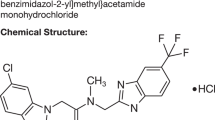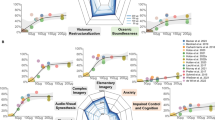Abstract
Selective serotonin reuptake inhibitors are the most commonly prescribed class of medications for patients with PTSD. However, many patients are not responsive to SSRIs and there is no rapid, uncomplicated way to determine who will benefit from this family of medications. Loudness dependence of auditory evoked potentials, a measure derived from auditory event-related potentials to a series of increasingly loud tones, appears to be strongly influenced by brain serotonin level and thereby holds considerable promise as an indicator of the brain’s potential responsiveness to SSRIs. The overarching goal of this chapter is to (a) describe the scientific rationale supporting the use of the LDAEP task in research advancing precision medicine approaches to the treatment of PTSD and (b) provide specific guidance to enable readers to administer this task in their own labs. Information regarding the requisite equipment is provided, as well as detailed instructions regarding the procedures for data collection, cleaning, and scoring.
Access this chapter
Tax calculation will be finalised at checkout
Purchases are for personal use only
Similar content being viewed by others
Abbreviations
- Cz:
-
Electrode placement at the central region of the cap on the midline
- EBA:
-
Electro-Based Adapter
- EEG:
-
Electroencephalogram
- ERP:
-
Event-Related Potentials
- Fz:
-
Electrode placement at the frontal region of the cap on the midline
- HEOR/HEOL:
-
Horizontal Electro Oculogram Right/Left
- LDAEP:
-
Loudness Dependence of Auditory Evoked Potentials
- M1/M2:
-
Left Mastoid/Right Mastoid
- Pz:
-
Electrode placement at the posterior region of the cap on the midline
- REF:
-
Reference
- SNRI:
-
Selective Norepinephrine Reuptake Inhibitor
- SSRI:
-
Selective Serotonin Reuptake Inhibitor
- VEOU/VEOL:
-
Vertical Electro Oculogram Upper/Lower
References
Grohol J (2016) Top 25 psychiatric medication prescriptions for 2013. Psych Central. http://psychcentral.com/lib/top-25-psychiatric-medication-prescriptions-for-2013/. Accessed 23 Sept 2016
Brady K, Pearlstein T, Asnis GM et al (2000) Efficacy and safety of sertraline treatment of posttraumatic stress disorder: a randomized controlled trial. JAMA 283(14):1837–1844
Davidson JR, Rothbaum BO, van der Kolk BA et al (2001) Multicenter, double-blind comparison of sertraline and placebo in the treatment of posttraumatic stress disorder. Arch Gen Psychiatry 58(5):485–492
Metzger LJ, Carson MA, Paulus LA et al (2002) Event-related potentials to auditory stimuli in female Vietnam nurse veterans with posttraumatic stress disorder. Psychophysiology 39(1):49–63
Buchsbaum M, Stevens S (1971) Neural events and psychophysical law. Science 172(3982):502–502
Carrillo-De-La-Pena MT (2001) One-year test–retest reliability of auditory evoked potentials (AEPs) to tones of increasing intensity. Psychophysiology 38(03):417–424
Hensch T, Herold U, Diers K et al (2008) Reliability of intensity dependence of auditory-evoked potentials. Clin Neurophysiol 119(1):224–236
Tenke CE, Kayser J, Pechtel P et al (2017) Demonstrating test-retest reliability of electrophysiological measures for healthy adults in a multisite study of biomarkers of antidepressant treatment response. Psychophysiology 54(1):34–50
Hegerl U, Juckel G (1993) Intensity dependence of auditory evoked potentials as an indicator of central serotonergic neurotransmission: a new hypothesis. Biol Psychiatry 33(3):173–187
Davis LL, Suris A, Lambert MT et al (1997) Post-traumatic stress disorder and serotonin: new directions for research and treatment. J Psychiatry Neurosci 22(5):318–326
Eison MS (1990) Serotonin: a common neurobiologic substrate in anxiety and depression. J Clin Psychopharmacol 10(3):26S–30S
Juckel G, Molnár M, Hegerl U et al (1997) Auditory-evoked potentials as indicator of brain serotonergic activity first evidence in behaving cats. Biol Psychiatry 41(12):1181–1195
Juckel G, Hegerl U, Molnár M et al (1999) Auditory evoked potentials reflect serotonergic neuronal activity—a study in behaving cats administered drugs acting on 5-HT1A autoreceptors in the dorsal raphe nucleus. Neuropsychopharmacology 21(6):710–716
Brocke B, Beauducel A, John R et al (2000) Sensation seeking and affective disorders: characteristics in the intensity dependence of acoustic evoked potentials. Neuropsychobiology 41(1):24–30
Wang W, Wang Y, Fu X et al (2006) Cerebral information processing in personality disorders: I. intensity dependence of auditory evoked potentials. Psychiatry Res 141(2):173–183
Carrillo-de-la-Pena M, Vallet M, Perez MI et al (2006) Intensity dependence of auditory-evoked cortical potentials in fibromyalgia patients: a test of the generalized hypervigilance hypothesis. J Pain 7(7):480–487
Siniatchkin M, Kropp P, Neumann M et al (2000) Intensity dependence of auditory evoked cortical potentials in migraine families. Pain 85(1):247–254
Croft RJ, Klugman A, Baldeweg T et al (2001) Electrophysiological evidence of serotonergic impairment in long-term MDMA (“ecstasy”) users. Am J Psychiatr 158(10):1687–1692
Tuchtenhagen F, Daumann J, Norra C et al (2000) High intensity dependence of auditory evoked dipole source activity indicates decreased serotonergic activity in abstinent ecstasy (MDMA) users. Neuropsychopharmacology 22(6):608–617
Senkowski D, Linden M, Zubrägel D et al (2003) Evidence for disturbed cortical signal processing and altered serotonergic neurotransmission in generalized anxiety disorder. Biol Psychiatry 53(4):304–314
Jaworska N, Protzner A (2013) Electrocortical features of depression and their clinical utility in assessing antidepressant treatment outcome. Can J Psychiatry 58(9):509–514
McPherson WB, Newton JE, Ackerman P et al (1997) An event-related brain potential investigation of PTSD and PTSD symptoms in abused children. Integr Physiol Behav Sci 32(1):31–42
Metzger LJ, Pitman RK, Miller GA et al (2008) Intensity dependence of auditory P2 in monozygotic twins discordant for Vietnam combat: associations with posttraumatic stress disorder. J Rehabil Res Dev 45(3):437–449
Lewine JD, Thoma RJ, Provencal SL et al (2002) Abnormal stimulus-response intensity functions in posttraumatic stress disorder: an electrophysiological investigation. Am J Psychiatr 159(10):1689–1695
Paige SR, Reid GM, Allen MG et al (1990) Psychophysiological correlates of posttraumatic stress disorder in Vietnam veterans. Biol Psychiatry 27(4):419–430
Gallinat J, Bottlender R, Juckel G et al (2000) The loudness dependency of the auditory evoked N1/P2-component as a predictor of the acute SSRI response in depression. Psychopharmacology 148(4):404–411
Juckel G, Pogarell O, Augustin H et al (2007) Differential prediction of first clinical response to serotonergic and noradrenergic antidepressants using the loudness dependence of auditory evoked potentials in patients with major depressive disorder. J Clin Psychiatry 68(8):1206–1212
Lee BH, Park YM, Lee SH et al (2015) Prediction of long-term treatment response to selective serotonin reuptake inhibitors (SSRIs) using scalp and source loudness dependence of auditory evoked potentials (LDAEP) analysis in patients with major depressive disorder. Int J Mol Sci 16(3):6251–6265
Lee TW, Yu YW, Chen TJ et al (2005) Loudness dependence of the auditory evoked potential and response to antidepressants in Chinese patients with major depression. J Psychiatry Neurosci 30(3):202–205
Linka T, Müller BW, Bender S et al (2005) The intensity dependence of auditory evoked ERP components predicts responsiveness to reboxetine treatment in major depression. Pharmacopsychiatry 38(03):139–143
Mulert C, Juckel G, Brunnmeier M et al (2007) Prediction of treatment response in major depression: integration of concepts. J Affect Disord 98(3):215–225
Paige SR, Fitzpatrick DF, Kline JP et al (1994) Event-related potential amplitude/intensity slopes predict response to antidepressants. Neuropsychobiology 30(4):197–201
Wade EC, Iosifescu DV (2016) Using EEG for treatment guidance in major depressive disorder. Biol. Psychiatry Cogn Neurosci Neuroimagin 1:411–422
Yoon S, Kim Y, Lee SH (2021) Does the loudness dependence of auditory evoked potential predict response to selective serotonin reuptake inhibitors?: a meta-analysis. Clin Pschopharmacol Neurosci 19(2):254
Linka T, Sartory G, Wiltfang J et al (2009) Treatment effects of serotonergic and noradrenergic antidepressants on the intensity dependence of auditory ERP components in major depression. Neurosci Lett 463(1):26–30
Park YM, Lee SH, Park EJ (2012) Usefulness of LDAEP to predict tolerability to SSRIs in major depressive disorder: a case report. Psychiatry Investig 9(1):80–82
Luck SJ (2014) An introduction to the event-related potential technique. MIT Press, Cambridge, MA
Nathan PJ, Segrave R, Phan KL et al (2006) Direct evidence that acutely enhancing serotonin with the selective serotonin reuptake inhibitor citalopram modulates the loudness dependence of the auditory evoked potential (LDAEP) marker of central serotonin function. Hum Psychopharmacol Clin Exp 21(1):47–52
Acknowledgments
Support for this work was provided by the Department of Veterans Affairs, Clinical Sciences R&D Service, Merit Award Program (CX001627-01A1; PI: Pineles).
Disclosures
Dr. Abi-Raad is affiliated with Compumedics USA Inc., the manufacturer and distributor of the hardware and software described in this report. Other authors report no conflicts of interest related to this study disclosure.
Author information
Authors and Affiliations
Corresponding author
Editor information
Editors and Affiliations
Rights and permissions
Copyright information
© 2023 The Author(s), under exclusive license to Springer Science+Business Media, LLC, part of Springer Nature
About this protocol
Cite this protocol
Pineles, S.L., Pandey, S., Shor, R., Abi-Raad, R.F., Kimble, M.O., Orr, S.P. (2023). Loudness Dependence of Auditory Evoked Potentials: A Promising Pre-treatment Predictor of Selective Serotonin Reuptake Inhibitor Response. In: Pinna, G. (eds) Translational Methods for PTSD Research. Neuromethods, vol 198. Humana, New York, NY. https://doi.org/10.1007/978-1-0716-3218-5_14
Download citation
DOI: https://doi.org/10.1007/978-1-0716-3218-5_14
Published:
Publisher Name: Humana, New York, NY
Print ISBN: 978-1-0716-3217-8
Online ISBN: 978-1-0716-3218-5
eBook Packages: Springer Protocols




